
Amphibians are ectothermic, anamniotic, four-limbed vertebrate animals that constitute the class Amphibia. In its broadest sense, it is a paraphyletic group encompassing all tetrapods excluding the amniotes. All extant (living) amphibians belong to the monophyletic subclass Lissamphibia, with three living orders: Anura, Urodela (salamanders), and Gymnophiona (caecilians). Evolved to be mostly semiaquatic, amphibians have adapted to inhabit a wide variety of habitats, with most species living in freshwater, wetland or terrestrial ecosystems. Their life cycle typically starts out as aquatic larvae with gills known as tadpoles, but some species have developed behavioural adaptations to bypass this.

The milk snake or milksnake, is a species of kingsnake; 24 subspecies are currently recognized. Lampropeltis elapsoides, the scarlet kingsnake, was formerly classified as a 25th subspecies, but is now recognized as a distinct species. The subspecies have strikingly different appearances, and many of them have their own common names. Some authorities suggest that this species could be split into several separate species. They are not venomous to humans.
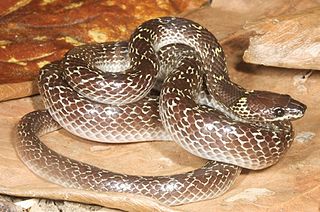
Lycodon capucinus, also known as the common wolf snake, is a species of colubrid snake, which is commonly found in the Indo-Australian Archipelago. Named after their enlarged front teeth, which gives them a muzzled appearance similar to canines, it also makes the snout somewhat more squarish than other snakes.

Sinomicrurus macclellandi, commonly known as MacClelland's coral snake, is a species of venomous snake in the family Elapidae. The species is endemic to southern and eastern Asia.

Candoia is a genus of non-venomous boas found mostly in New Guinea, Melanesia, the Solomon Islands and the Maluku Islands in Indonesia. Common names include bevel-nosed boas and keel-scaled boas.
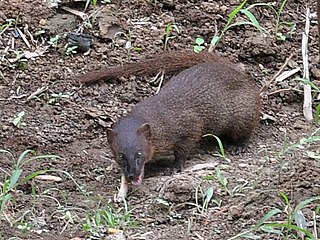
The Javan mongoose is a mongoose species native to Southeast Asia.
The Malayan flying frog is a species of frog in the moss frog family (Rhacophoridae). It is found in Indonesia, Malaysia, and Thailand.

The Java mouse-deer is a species of even-toed ungulate in the family Tragulidae. When it reaches maturity it is about the size of a rabbit, making it the smallest living ungulate. It is found in forests in Java and perhaps Bali, although sightings there have not been verified.

Trimeresurus sumatranus is a species of venomous pitviper found in the tropical forests of Indonesia, Malaysia and Thailand. Arboreal by nature, its coloration is pale to neon-green, with some black vertical markings, and a red-tipped tail. As with other vipers, this species has prominent, “keeled” scales, which appear somewhat raised and give the snake a rough-textured appearance. Common names include Sumatran pitviper, Sumatran tree viper, and Sumatran pit viper.

Bothrops bilineatus, also known as the two-striped forest-pitviper, parrotsnake, Amazonian palm viper, or green jararaca, is a highly venomous pit viper species found in the Amazon region of South America. Two subspecies are currently recognized, including the nominate subspecies described here. A pale green arboreal species that may reach 1 m (3.3 ft) in length, it is an important cause of snakebite throughout the entire Amazon region.

The elephant trunk snake or the Javan file snake, is a species of snake in the family Acrochordidae, a family which represents a group of primitive non-venomous aquatic snakes.

The red-headed krait is a large highly venomous elapid snake with dramatic coloration. The red-headed krait can grow to a length of up to 2.1 metres (7 ft). It lives in lowland rain forest, including those on islands, but it is considered uncommon. It feeds primarily on specific snakes, probably semiaquatic and fossorial snakes. In Southeast Asia, the red-headed krait occurs in Malaysia, Singapore, Thailand and Indonesia (Sumatra), with a subspecies in Borneo. The venom potency is little-studied, as bites from this species are extremely rare.
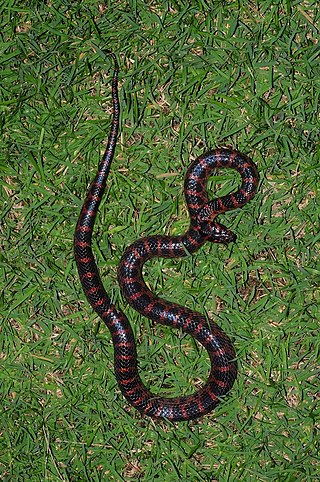
Lycodon rufozonatus is a species of snake in the family Colubridae. The species is native to East Asia. It is medium-sized, nocturnal, and is considered non-venomous. Two subspecies are recognised: one of which, L. r. walli, is restricted to the Ryukyu Archipelago; the other, L. r. rufozonatus(Cantor 1842), is found in only in Korea & China.

The golden-crowned snake is a small species of venomous snake in the family Elapidae. The species is endemic to Australia.

Xenodermidae is a family of snakes native to East Asia, South Asia, and Southeast Asia. All species in the family Xenodermidae are small or moderately sized snakes, never more than 80 cm (31 in) but typically less than 55 cm (22 in) in total length. They are secretive, probably nocturnal, and typically inhabit moist forest habitats. They seem to be opportunistic carnivores, preying on other vertebrates.
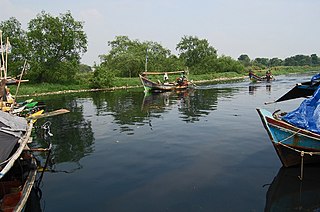
Muara Angke mangrove forest and wildlife sanctuary is a protected nature conservation area at Kapuk Muara, Penjaringan along the north coast of Jakarta, Indonesia. Muara Angke Wildlife Sanctuary is located at the end of Muara Karang Raya street, near Mediterranean Gallery shopping complex.
The bluebelly Java snake, also known commonly as Fruhstorfer's mountain snake and the Javan bluebelly snake, is a species of snake in the family Colubridae. The species, which is the only member of the genus Tetralepis, is endemic to Java.
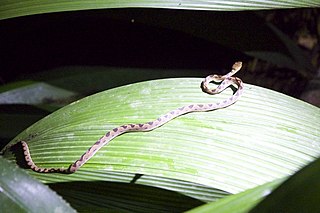
Leptodeira septentrionalis, the northern cat-eyed snake, is a species of medium-sized, slightly venomous snake, found from southern Texas to Costa Rica.

The Javan spitting cobra, also called Indonesian cobra or Komodo spitting cobra, is a species of cobra in the family Elapidae, found in the Lesser Sunda Islands of Indonesia, including Java, Bali, Lombok, Sumbawa, Flores, Komodo, and others.

Crocosaurus Cove is a crocodile herpetarium and aquarium attraction located in an indoor-outdoor complex in the city district of Darwin, Northern Territory, Australia. Its main focus, as the facility's name indicates, is the tourism drawcard of northern Australia – crocodiles.



















